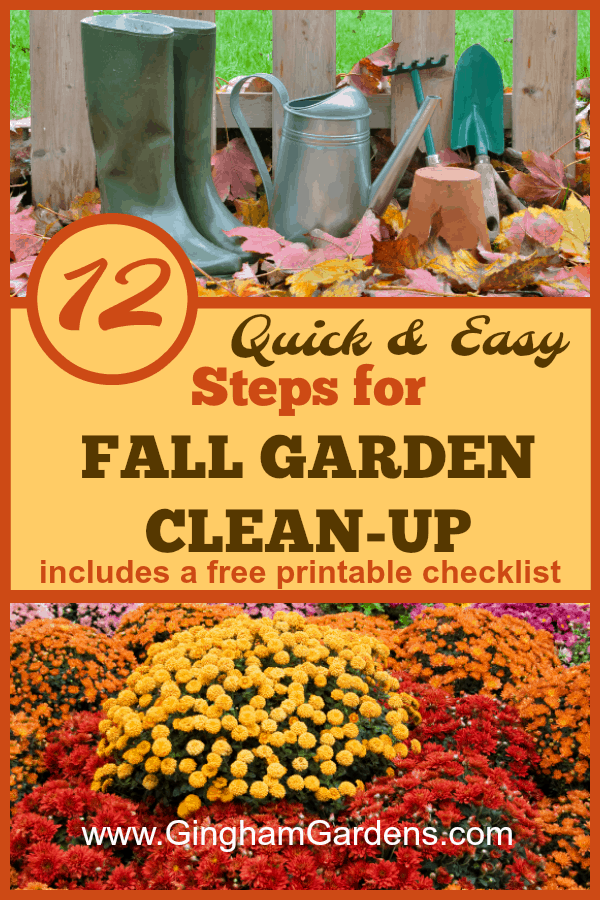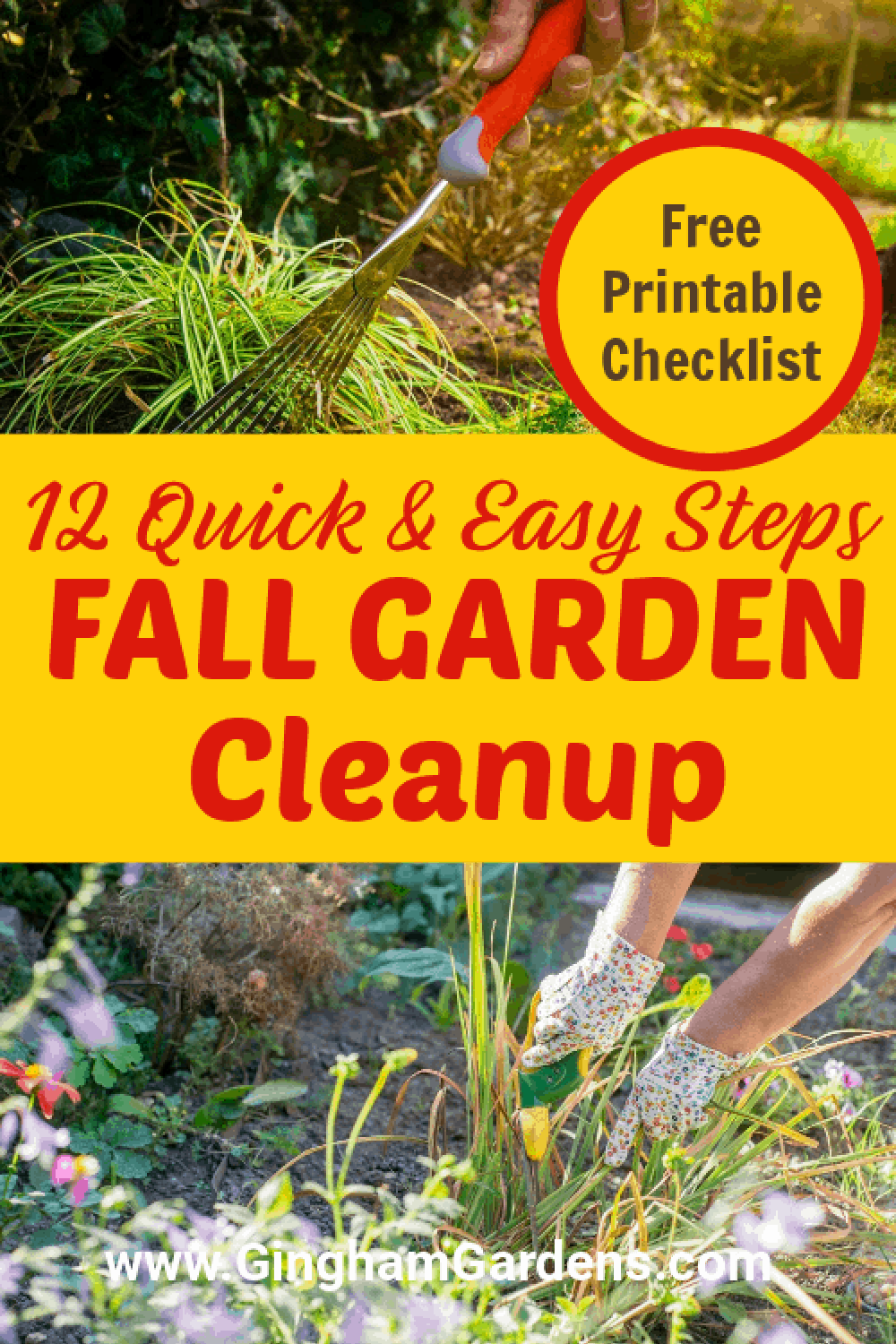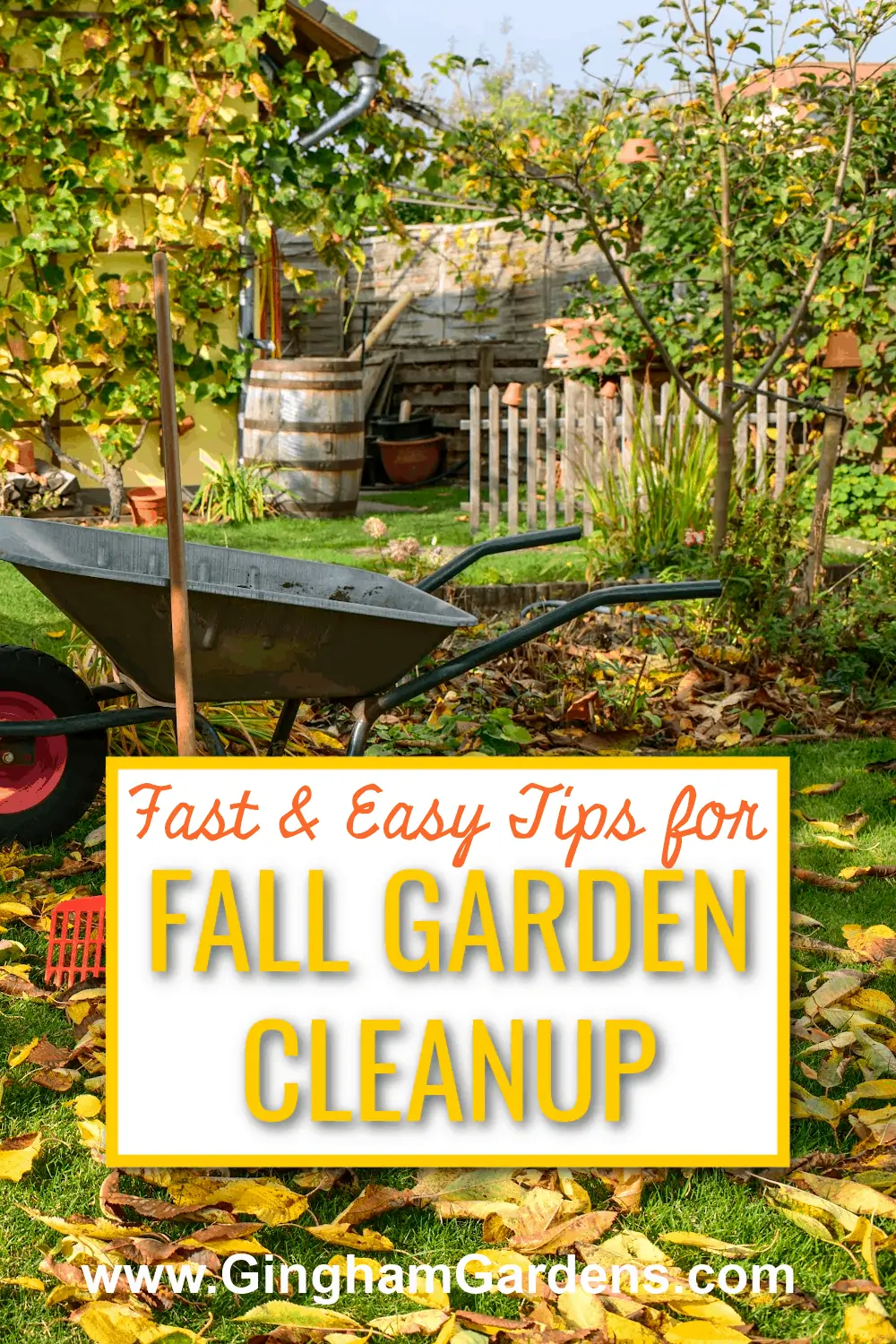Quick & Easy Steps for Fall Garden Clean Up
Fall really is a great time to garden. The first reason is that the temps have cooled down. But, the main reason is that it gives us gardeners a head start on next spring. I’ll be honest and say that as the gardening season winds down, I’m usually ready for a break. The flowers are tired and I’m tired, BUT, when I push myself and get these things done in the fall, it just simply makes for a better spring. So I’m challenging myself and you, to get out there and check these items off the never-ending garden to-do list. Next season, we’ll be so happy we did. Follow along as I lay out these Quick & Easy Steps for Fall Garden Clean Up.
This post contains affiliate links. If you click on
one of the links and make a purchase,
I may receive a small commission at no additional cost to you.
See full disclosure here.
So not a lot of beautiful garden pictures today, just down to the nitty, gritty chores of maintaining and having healthy gardens. If you’re looking for pretty, here are some fun Fall Porch Decor and Outdoor Decorating Ideas.
The Dilemma: To Clean or Not to Clean Your Gardens in the Fall
Gardeners all over are divided on the topic of Fall Garden Cleanup and whether you should or shouldn’t clean up your gardens in the fall. This isn’t really the place for the debate, but I will do my best to offer a balanced approach.
If you’re worried about having places for beneficial insects to hibernate, here are some things to think about. Consider your surrounding area, are there meadows within close proximity to your home? Are there wooded areas? Are there roadsides where grasses and weeds are left to grow? Is there a brush pile in your yard? If you answer yes to any of these questions, native bees, pollinators and other critters will be fine. We have included a few other tips throughout the post for helping out our birds and pollinators.
If you have problems with insect pests or diseases in your gardens, it’s best to get the mess cleaned up. Also, if you have mice or voles in the gardens, don’t encourage them by creating a winter habitat for them.
There’s really no right or wrong answer here. You decide what works for you and just go with it.
How to Cleanup Flower Gardens
When I set my mind to it and don’t get side-tracked, I can get my perennial beds cleaned up fairly quickly. Here’s what I do:
- I make a pass through my flower beds with my wheelbarrow and pick up all the decor pieces and garden art. I then brush the pieces off or hose them down, dry them and store them for winter.
- Make a quick sweep through the flower beds and pull all the annual plants and weeds. I don’t recommend composting weeds, but the annuals can be tossed into the compost bin. If you want to collect seeds from your annuals, don’t forget to do that first. After I pull the annuals, I like to give them a good shake over the ground to see if I can get any volunteers next year. This works really well with snapdragons, alyssum and sometimes marigolds. Give it a try. Check out this post on annual flowers that reseed.
- And lastly, on the flower beds, I take the weed whacker and cut back all the perennials. Be sure to leave some seed heads for the birds. As a side note, I love, love, love this weed whacker. It’s lightweight and super easy to use (even for a girl). My hubs loves it too and has pretty much forsaken his gas powered beast for this battery powered one.
- As an extra step, in the perennial garden, and one I always appreciate in the spring, go through and replace any missing or faded plant tags, or ones you might have chopped up with the weed whacker (speaking from experience).
- I usually go through and lightly rake my flower beds at least once in the fall and that cuts down on the amount of clean up I have to do in the spring. If you have a problem with rotting perennials or rotting bulbs, it’s especially important to get as much leaf debris off your flower beds. This rake is the best for cleaning up flower beds in the fall. It’s adjustable, which makes it so much easier to get around and between your plants, stones and fencing.
- Consider creating a small pile of hollow stems and dead plant material somewhere in your garden or yard as a winter home for beneficial insects.
Fall Garden Clean Up – Vegetable Gardens
Clean out the vegetable beds. This is an easy task for me because I only have 4 – 4×4 raised beds to clean out. Here’s what I do:
- Pull all the vegetable plants after the first frost, or when the plants stop producing.
- Chop them up, either with a shovel; or, I just toss the dead plants in the yard and run the lawn mower over them and then throw the ground up mess back on top of the soil. This is much easier if you have a bag on your mower. Or, just throw the plants in the compost.
- You can also toss mulched leaves and grass clippings on top of the beds as well.
- In the spring, the composted leaves, plants and grass clippings can be tilled into the soil and then raked out smooth.
- Just a note here, if you had a significant pest or disease problem in your vegetable gardens, It’s a good idea to clean the veggie beds well and just leave bare soil (or sow a cover crop) for the winter. Also, don’t toss diseased plant debris in your compost pile.
Fall Garden Clean Up – Container Gardens
I usually just dump my containers into a big plastic wheelbarrow that has a hole in the bottom for drainage, chop it up as best I can and leave it to compost over winter and then reuse the soil the following spring. Or, in many cases, I simply leave the soil in the planters and just leave them over winter. Here are a few other things I do with my containers:
- I pull out any perennials that I’ve used in container gardens and plant them in the ground. I have lots of creeping jenny in containers and it’s actually a perennial here in Zone 4. To save money, I will dig it all out of the planters and put it in a small nursery pot and bury the plant, pot and all. This also works with vinca vine and ivy, but be sure they have a good leaf cover. Hosta is another perennial that I use in shady container gardens that needs to be planted back in the ground if you’re in a colder garden zone.
- Take some cuttings from plants like coleus to start some new babies indoors. Coleus can be rooted very easily in water, or by using a rooting hormone powder. I have some beautiful variegated ivy in my window box that I’m going to take some cuttings from too.
- If you have Caladium, Dahlias, Tuberous Begonias, Canna Lilies, Calla Lilies, Gladiolas, etc., in colder climates these plants will not overwinter outdoors and have to be replanted every spring. However, the tubers or bulbs can be dug and stored over winter indoors and planted again next spring. It’s a great way to stretch your gardening budget. Also, next year’s plants will be larger and will grow bigger and better every year. If you are interested in learning how to over-winter tender bulbs check out the post – How to Overwinter Tender Plants. Zonal Geraniums are also really easy to overwinter. You can see how in the post – How to Keep Zonal Geraniums Over Winter.
Protect New Shrubs and Trees
First of all, if you have newly planted trees or shrubs in your landscape, be sure they go into winter adequately watered.
Protect shrubs from winter damage caused from hungry critters by creating a cage of wire hardware cloth to encircle the bottom portion of the shrub. A couple of rabbits can decimate shrubs during the winter. To protect young trees and small fruit trees from critters, use plastic tree guard protectors. It works best to bury the protector around the tree, so that rodents can’t get to the bottom of tree trunks.
Do you have evergreen shrubs or trees, such as arborvitae and/or dwarf Alberta spruce trees, that are sensitive to winter burn? If so, be sure to wrap them loosely before the first hard frost. To learn more about protecting trees from winter burn, be sure to check out this very informative article from the University of Minnesota.
Fall Is The Best Time To Prepare New Garden Beds
Stake out any areas where you want to create a new garden bed. This method (known as the “Lasagna Method”) works very well for me. I have used this method on several areas in my yard.
- Mow the grass or weeds down as low as possible.
- Cover the area with cardboard or a good layer of newspaper. If you don’t have either of those, these work great (in fact I like them better)
- Cover the cardboard or newspapers with grass and leaf litter.
- If the forecast doesn’t show rain in the next few days, soak the area really well with the hose.
- In early spring, with just some simple prep, you’ll have an area that’s ready to plant. The soil has been fortified from the paper, dead leaves and grass clippings over the winter months. I would recommend tilling the area to mix the organic matter into the soil. Then, with a little raking, you will have a blank slate in which to create your garden bed, whether it be for flowers, veggies or any other kind of garden.
For more information on prepping new garden areas, this post will give you more ways to do so – Converting Lawn Into Garden Space.
To help remind you of this post later, here’s a Pin to add to one of your favorite gardening boards on Pinterest. There are more pins at the bottom of the post. Thanks for pinning!
Storing Your Garden Tools for Winter
I’m pretty lackadaisical about cleaning my gardening tools before storing them for the winter. It’s definitely an area where I need to improve. It’s especially important if you’ve had to cut back any diseased plant material. Here are some simple steps for cleaning your tools:
- To clean your gardening tools, simply wipe them down with a diluted bleach/water solution or rubbing alcohol.
- This oil is made specifically for gardening tools and doesn’t cause dirt to stick to the tools. I have found that this oil does really keep my pruners and gardening shears in good working order. All it takes is applying a thin coat of oil to metal parts, let it sit for a minute or two and then wipe the tool clean. Watch out for those sharp blades though.
As far as winter storage goes, be sure to store your tools in a dry part of your gardening shed or garage.
Other Fall Gardening Projects & Planning
To help keep myself on task, I put together a handy checklist that’s available in the Gardening Resources Library. Get your own Fall Garden Clean Up Checklist and instant access to all the free gardening printables by completing the subscription form below.
There’s still plenty of time for most of us to get our fall gardening projects completed before the ground freezes and the snow flies. Here are some articles that will help you get some of those fall gardening projects done:
All About Seed Collecting
Planting Bulbs for Amazing Spring Flowers
The Best Fall Perennial Flowers
And, the very best Resource for keeping me on track with all my Gardening Projects is my Garden Journal. Check out DIY Garden Journal to learn more.
Late Summer and Fall are perfect for planning your gardens for next year. Learn how and get some excellent tips in Garden Planning – How to Plan Next Year’s Gardens.
That’s it for my Fall Garden Clean Up Tips. Do you clean up your gardens in the fall, or do you wait for Spring? Leave a comment (at the bottom of the page) and let me know.
Happy gardening,
Joanna
p.s. Please help me out by pinning these pictures. Simply hover in the upper left-hand corner and click the “pin” icon. There are more pins at the bottom of the page. Thanks!!!!
p.p.s. Follow Gingham Gardens on Pinterest for lots of great gardening ideas and tons of gardener’s eye candy.
Our Favorite Tools for Fall Garden Cleanup:
Pins to Share:




